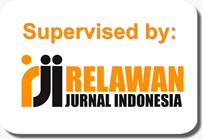EFFECT OF MOTIVATION AND DISCIPLINE ON EMPLOYEES PERFORMANCE OF PT. CIPTA CATUR MAHKOTA
Abstract
Full Text:
PDF (Bahasa Indonesia)References
Alam, S. (2016). PENGARUH KOMUNIKASI, MOTIVASI, DAN DISIPLIN KERJA TERHADAP KINERJA PEGAWAI LEMBAGA PENJAMINAN MUTU PENDIDIKAN. Katalogis, 2, 143.
Ariffin, M. (2015). The Influence of Competence, Motivation, and Organisational Culture to High School Teacher Job Satisfaction and Performance. International Education Studies, 43.
Ardana, I. K., Mujiati, N. W., & Utama, I. W. M. (2012). MANAJEMEN SUMBER DAYA MANUSIA (1st ed.). Yogyakarta: Graha Ilmu.
Baskoro, C. A. (2014). PENGARUH KEPEMIMPINAN TRANSFORMASIONAL, MOTIVASI DAN DISIPLIN KERJA TERHADAP KINERJA KARYAWAN. Management Analysis, 10.
Fahmi, I. (2016). Manajemen Sumber Daya Manusia, Teori dan Aplikasi. Bandung: Alfabeta.
Hamali, A. Y. (2016). Strategy Pemahaman Manajemen Sumber Daya Manusia : Strategi Mengelola Karyawan. (B. Seda, Ed.) (1st ed.). Yogyakarta: CAPS (Center for Academic Publishing Service)
Hasibuan, M. S. . (2017). Manajemen Sumber Daya Manusia. Jakarta: PT. Bumi Aksara.
Hersona, S., & Sidharta, I. (2017). INFLUENCE OF LEADERSHIP FUNCTION, MOTIVATION AND WORK DISCIPLINE ON EMPLOYEES’ PERFORMANCE (Case on Department of Manpower and Transmigration Karawang Regency). Journal of Applied Management (JAM), 15, 536.
Jeffrey, I., & Soleman, M. (2017). The effect of work discipline, achievement motivation and career path toward employee performance of The National Resilience Institute of The Republic of Indonesia. Application or Innovation in Engineering & Management, 6, 112.
Martinus, E. (2016). Pengaruh Kompensasi dan Motivasi Kerja Terhadap Kinerja Karyawan Pada PT Devina Surabaya. Ilmu Dan Riset Manajemen, 5, 15.
Potu, A. (2014). KEPEMIMPINAN, MOTIVASI, DAN LINGKUNGAN KERJA PENGARUHNYA TERHADAP KINERJA KARYAWAN PADA KANWIL DITJEN KEKAYAAN NEGARA SULUTTENGGO DAN MALUKU UTARA DI MANADO. Jurnal EMBA, 1, 1217.
Priyatno, D. (2010). Paham Analisis Data dengan SPSS. Yogyakarta: Cetakan Pertama Mediakom.
Priyono, I., Marzuki, & Soesatyo, Y. (2015). tentang Influence of Leadership Function, Motivation and Work Discipline on Employees Performance (Studies on, Department of Manpower and Transmigration Karawang Regency). Global Economics, Management and Business Research, 218.
Riani, A. L. (2013). MANAJEMEN SUMBER DAYA MANUSIA MASA KINI. Yogyakarta: Graha Ilmu.
Rivai, V. (2011). Manajemen Sumber Daya Manusia Untuk Perusahaan : Dari Teori ke Praktik. Jakarta: Rajawali Pres.
Rumengan, J. (2013). METODOLOGI PENELITIAN. Bandung: Citapustaka Media Perintis.
Sanusi, A. (2011). Metodologi Penelitian Bisnis. Jakarta: Salemba Empat.
Sarwono, J. (2012). Metode Riset Skripsi : Pendekatan Kuantitatif (Menggunakan Prosedur SPSS). Jakarta: Elexmedia Komputindo.
Sedarmayanti. (2011). Manajemen Sumber Daya Manusia : Reformasi Birokrasi dan Manajemen Pegawai Negeri Sipil. Bandung: Refika Aditama.
Sunyoto, D. (2012). Manajemen Sumber Daya Manusia. Jakarta: CAPS (Center for Academic Publishing Service).
Sugiyono. (2012). Metode Penelitian Kuantitatif Kualitatif dan R&D. Bandung: Alfabeta.
Tindow, M. I., Mekel, P., & Sendow, G. (2014). DISIPLIN KERJA, MOTIVASI DAN KOMPENSASI PENGARUHNYA TERHADAP KINERJA KARYAWAN PADA PT. BANK SULUT CABANG CALACA. EMBA, 2, 1604.
Tumilaar, B. (2015). THE EFFECT OF DISCIPLINE, LEADERSHIP, AND MOTIVATION ON EMPLOYEE PERFORMANCE AT BPJS KETENAGAKERJAAN SULUT. Jurnal EMBA, 3, 787–796.
Wibowo, A. E. (2012). APLIKASI PRAKTIS SPSS DALAM PENELITIAN. Batam: Gava Media.
Wibowo. (2014). Manajemen Kinerja. In 4 (Ed.). Jakarta: Rajawali Pers.
Wirawan. (2009). MANAJEMEN SUMBER DAYA MANUSIA INDONESIA : Teori, Aplikasi dan Penelitian. Jakarta: Salemba Empat.
DOI: https://doi.org/10.31846/jae.v6i3.96
Refbacks
- There are currently no refbacks.

This work is licensed under a Creative Commons Attribution-NonCommercial-NoDerivatives 4.0 International License.
e-Jurnal Apresiasi Ekonnomi Indexed by:












